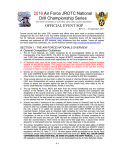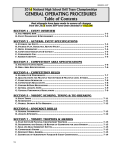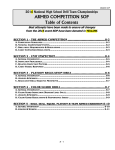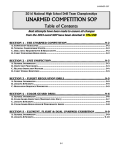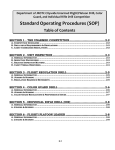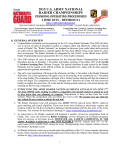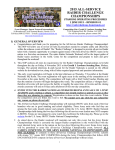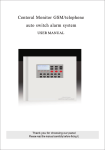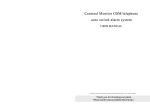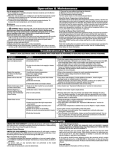Download 2016 Army Cadet Command JROTC Nationals
Transcript
2016 Army Cadet Command JROTC Nationals Drill Championships Kentucky international convention center "Motivating Young People To Be the best they can be" Best attempts have been made to ensure all changes from the 2015 event SOP have been denoted in YELLOW. SECTION 1 – THE “ARMY NATIONALS” OVERVIEW ver 1 – 09‐10‐2015 A. The Competition Overview 1. This SOP will include all information that is pertinent to the competition and necessary for your team's preparation & attendance at the Army Nationals. The event will be more affectionately known as the Army Nationals. This event is designed to bring together many of the finest Army JROTC drill & ceremony JROTC programs to crown the best in both Armed & Unarmed Drill in numerous disciplines. 2. The Army Nationals website (http://army.thenationals.net) will be focal point for distribution of all event information. The event website allows all schools to enter the Army Nationals event, submit all event paperwork, and pay all competition costs DIRECTLY ON‐LINE. This will be done through the MyTeam website (http://myschool.thenationals.net), found directly on the Army Nationals website. 3. No Commander’s Call will be utilized for this event. Instead, start times and all event information is posted on the event website in advance. Accepted Army Nationals schools must download, complete and submit these items, as well as input needed team information on‐line. SNI does send an email for any major changes, however schools should check the website weekly closer to the event to ensure they have the latest materials. 4. Along with the rules and regulations of the meet, this document will also maintain information on both the structure & management of the event by Sports Network International, Inc. (SNI). To ensure a successful Army Nationals experience, please internalize all of the regulations of the Army Nationals found within this document and the Army Nationals website. 5. The Army Nationals are managed by Sports Network International, Inc. As the civilian contractor for the USACC, Event Manager SNI is tasked to be responsible for organizing all aspects of the competition, from setting up the rules and procedures, scoring, trophies, etc. to training necessary judges in accordance with the wishes of the USACC. The Army Nationals are supported by the efforts of the 7th Brigade as well. 6. The Army Nationals are judged where applicable in STRICT accordance with the newest revision of Army Training Circular, TC 3‐21.5 downloadable from the Army Portal and the SNI website. Judges are obtained from active duty and recently retired positions with string backgrounds in the areas they will be grading. SNI takes the acquisition and training of the judges very seriously. While the Training Circular was never designed to grade cadets marching in boxes, much of what is written is completely applicable. Our goal is to reinforce these areas to the judges before and during the event to make these standards hard and fast for every competing team where they apply. 7. All competitors, instructors, and team supporters are subject to comply with all of the rules & procedures of this SOP and of the Army Nationals. Any items not specifically covered by your service manual(s) or by SNI regulations are at the sole discretion and determination of the Judging Director. 8. If you have a question regarding any facet of the Army Nationals, look through this SOP and the official website to answer your question ‐‐ in most cases, the answer is maintained in print. If you do not find the answer, please feel free to email or call the Competition Director Justin Gates ([email protected]) or telephone SNI in advance of the event on the 800 number. Please do not wait to ask your questions on site. 4-1 B. Event Management Items 1. Schools will be nominated to attend the Army Nationals from their Brigades OR schools may simply register and attend without such nomination. However, nominated schools will receive benefits including priority registration, priority scheduling and other extras. The exact method each Brigade will use to select the representatives will be left up to the Brigade. 2. The United States Army will maintain sole control over any cancellation of this competition. IF FOR ANY REASON the event is cancelled; all schools will be given a full refund of any school registration fees paid. SNI will also ship all shirts & medallions that have been purchased for your cadets pre‐paid. C. Package Plan, Deadlines, Entry Info & Refund Policy 1. Because the Army has contracted the event, the registration fee to attend the Army Nationals is set at a discounted $100 per school (not per team, per school). All participating cadets at the Army Nationals MUST participate in the event through the Team Package Plan. Through this plan, we are able to pay all of the costs associated with an event of this nature. In organizing your attendance, remember that all participating cadets are required to pay just a $10.00 Team Package Fee. Instructors and other non‐competing cadets in your program CAN receive this package if they CHOOSE to do so but it is NOT required. However, when you look at the value for what you receive, you may wish to add administrators, instructors and even parents as they will receive the competition shirt, competition medal and the gorgeous 8” x 10” color team photo. 2. As stated from Cadet Command, Brigades are encouraged to nominate and assist your deserving schools to attend the event within means available. Therefore, schools planning to attend “hell or high water” should contact their Brigades and gain acceptance no later than 10 December of this year. Many schools will enter and be accepted AFTER this date, but history dictates this will be the date a school who KNOWS they want to attend should gain approval and register. 3. Selected competition slots will be reserved to ensure all Brigades have representation at this meet to ensure a good geographic diversity for competitors. That said, we expect every school to be self‐motivated, hard‐ charging and they must do the work needed to attend well in advance. Schools (especially those coming from great distances) should be working NOW on and off the drill floor to make their trip a reality. SNI will ensure all Brigades have the ability to be represented with solid numbers BUT all Brigades must work with many of their best teams (and they know who they are) NOW to ensure they are fundraising, practicing and doing the things that will allow them the best chance to make their trip a reality come competition time! 4. Once your school has registered into the Army Nationals, School Registration Fees are completely nonrefundable. The Refund Exception Policy is outlined below under “Important Refund Exception Note”. Also, schools that do not submit the required paperwork and/or the Team Package Fees on–time may be removed from the event with no refund of the school's registration fee. 5. MOST IMPORTANT: After submitting the School Registration Fee and Team Package Fees, these monies are totally NON‐REFUNDABLE. SNI must pay for the many items involved within the Team Package Plan (shirts, medallions, photography items, numerous competition related items). If it is necessary to cancel or “drop” anyone who has paid the Team Package Fees, the school should find someone else from the program to substitute for that person as they cannot be “dropped”. If this is not done, the school will pay for & receive all of the package materials they requested. You are responsible for the total number of packages you have requested (including changes called in by telephone.) Again, the refund exception policy is outlined below. 6. To add any individuals to your paperwork after you have sent in the paperwork and money, this can be done yourself on your MySchool website until just weeks before the event. At this time, changes are locked out and a telephone call is the best method to assist. DO NOT fax, email or mail revised participant lists or other changes. Depending on the balance you owe for these individuals, SNI will either have you send a supplemental payment or pay the balance upon arrival. You should always verify any changes by checking your MY SCHOOL website. Important Refund Exception Notes: SNI understands that a blanket refund policy may appear inflexible. Understand however that over 10K dollars in non‐refundable, up‐ front payments are made by SNI each year to ensure every team coming to the event has a fantastic, well‐planned competition. Teams simply deciding not to attend, albeit for valid reasons, would make hosting this event impossible to accomplish. Because of world events and the often over‐reaction that can occur from schools and school boards, SNI will refund any school registration fee should a school board, principal, or other governmental oversight body ban school travel (and therefore your attendance) PRIOR to the Team Package Fee deadline. (Note: all teams should find out their current school board policy regarding travel BEFORE registering to enter this event). IF FOR ANY REASON the event is cancelled; all schools will be given a full refund of school registration fees paid. SNI will ship at our expense all pre‐paid event shirts and medallions to your unit. Understand that SNI will not put cadets or anyone else at risk through attending the Army Nationals. Thank you for your understanding on this matter. 4-2 SECTION 2 ‐ THE ARMY NATIONALS COMPETITION A. Competition Mechanics 1. The “Army Nationals” are widely recognized by all knowledgeable drillers as the official Championship of Army JROTC. The past Army Nationals events have maintained the largest Army‐only competition fields in history and this year should be no different. The Army Nationals will continue to provide outstanding opportunities to showcase Army JROTC excellence! 2. On site, schools will check in at the Event Registration Desk that morning on arrival. At this time, each school will receive a complete event schedule book, as well as the t‐shirts, medallions, and team photo paperwork. It also allows SNI to know your school has arrived at the event. Event Registration is the first thing you must do upon your arrival at the complex. No assigned seating is in effect so schools may sit anywhere in the arena they choose. 3. The event maintains BOTH an Armed Division competition and an Unarmed Division competition. Cadets MAY NOT compete in BOTH division for any reason. Both of these divisions are trophied and scored separately. This will allow smaller schools to better compete with larger schools who generally split their “talent” and form two competition units. There is NO Grand Championship or other grand overall scoring that combines Armed & Unarmed team scores as regulations maintain the Armed & Unarmed qualifiers doing so independently, giving smaller schools a better shot within their own division of competition. 4. Those schools gaining a top three overall finish in either the Armed or Unarmed Division at the Army Nationals will receive automatic acceptance and priority scheduling should they choose to attend and compete against the best schools from all services in the nation at the all‐service 2016 Nationals in Daytona Beach, Florida in early May. 5. The following team events are counted toward the Division Championship point totals: Team Inspection, Platoon Regulation, Color Guard, Exhibition Drill. Teams must enter and obtain a score in all four events in their division to win the division title. All teams are eligible to win team trophies within each specific event entered, no matter what other events the team enters. First through fifth place team trophies are awarded in each team event listed above. 6. Schools will be allowed a maximum of two complete drill teams (one Armed and/or one Unarmed team) into the Army Nationals competition, providing that no individual cadet competes for both teams. This rule allows a school to enter two complete teams but does not allow individual cadets to compete on both the Armed & Unarmed teams. This better allows smaller schools to concentrate their talent and compete on a more equal playing field. 7. Again this year, the Army Nationals will maintain a solo & dual ARMED EXHIBITION COMPETITION and a DUAL UNARMED EXHIBITION competition. Every school will be allowed a single entrant in the division they have entered. Detailed specifics on this will be released when space and judging numbers are conformed closer to the event. 8. As the Event Director for the Army Nationals, Sports Network International (SNI) maintains sole judgment pertaining to the actual drill competition. All decisions made by SNI regarding rules, procedures or other matters necessary to the running of the drill competition are final with no protests entertained. 9. The competition will end with an awards ceremony with cadets forming on the main floor. This will be a fast, non‐elaborate ceremony as we know teams will be ready to get onto the road. Specific times for the competition day will be posted separately for each school one week prior to competition. B. Weapon Requirements & Regs ‐ Armed Teams & Color Guards 1. In order for any team to compete at the Army Nationals, the weapons in use by the entire unit must fit a series of standards that qualify it to be considered "Regulation". These criteria require that the weapon MUST: be rendered unfireable by one of several methods including but not limited to: ‐ leading the barrel; ‐ removing the firing pin; or any other means leaving the weapon unable to mechanically fire. if a trigger is present, the weapon must maintain a trigger guard. The weapon must have an adjustable sling. 2. No weight requirements are listed above because any weapon regardless of weight may be used so long as the weapon meets the above criteria at the Army Nationals. Also, the use of front and/or rear sights are strongly discouraged by SNI on any weapon used for exhibition drill. They can cause severe injuries and serve no purpose on these non‐firing weapons. 4-3 3. The event Head Judge may visually and/or physically inspect one or more rifles among the set the team will use during that portion of the Army Nationals competition. Should any weapon not meet ONE OR MORE of the above criteria, a subjective penalty WILL be added to the offending scoresheet by the Judging Director. 4. Teams are permitted to strap/tape their slings to the stock of their weapons ONLY during the Exhibition portion of the competition. Teams MAY apply tape to their weapons in any manner they deem appropriate. Teams MAY NOT REMOVE their weapon slings during any event at the Army Nationals. If this is done, a subjective penalty WILL be added to the offending scoresheet by the Judging Director. 5. Although all team members must compete with the same style weapon during each particular event, teams are allowed to utilize a different set of weapons for different team events (i.e. one set for Exhibition, another for Regulation). However, all weapons used must fulfill all of the requirements set forth for a regulation weapon. 6. The definition of a "dropped" drill rifle is when a drill rifle unintentionally leaves the CONTROL of a cadet and strikes the drill surface. With this definition, little judgment should be in play. Judges will certainly reduce scores for bobbles and other poor rifle control as well. No other element of the Armed competition is more stressed. 7. Some teams may have drill rifle bolts that are either mechanically unsound or are welded shut. Judges will expect these units to go through the physical hand movements to open the bolt when going to Inspection Arms to display to the judge that you know how the movement should be done. If asked by a judge why you didn’t physically open/close the bolt, explain the reason (as this would be a logical question for the judge to ask). 8. POINT OF EMPHASIS, at no time may any drill rifle be struck on the marching surface by the BARREL! This can cause severe floor damage and poses a greater chance of damage to the rifle as they are not constructed to absorb this blow. Judges generally do not LIKE IT, and therefore teams should NOT execute it. A subjective deduction can be initiated by the judges and/or the Competition Director if it is witnessed. C. Cadet Commander Regulations 1. Armed Division cadet commanders MUST carry either a rifle, saber or sword during ALL team events at the Army Nationals. All other cadets must carry a rifle. No other weapons (i.e. demilitarized handguns) are allowed. In the Unarmed Division, cadet commanders MAY, if they wish, carry a saber or sword only. No other cadet may carry any weapon of any type (except the rifle bearers during color guard competition). 2. It is not permitted for a saber or sword to leave a commander's hand at any time upon entering the drill floor. When using a saber or sword, the commander must remain AT LEAST TWO PACES away from an event Head Judge when reporting in and reporting out. Violation of this rule will cause the Head Judge to retreat to a safe distance. Although there is no specific deduction for this action on the scoresheet, the action will certainly be reflected in the overall evaluation scoring by the event Head Judge, as well as the other event judges. 3. Allowing that each drill team is instructed differently, judges will evaluate any vocal projection of cadet commanders in the following manner. During Inspection and in evaluating the commander during the Regulation event, an individual's voice projection, confidence, and tone will be the criteria upon which judges will base any vocal evaluations. D. Uniform Regulations 1. Cadets will be required to maintain either an approved class A or class B uniform (as called for within Cadet Command reg 670‐1) during Inspection, Regulation and Color Guard competition at the Army Nationals. Noted exceptions to the class A or B uniform will be the allowance of berets in all events. During Platoon Regulation competition, units may remove name tags and ribbons to protect their uniform from tearing. Additionally, during Color Guard, units may remove the jacket, along with name tags and ribbons as it can restrict movements. Only during Team Exhibition may any unit vary from the class A or B uniform policy outside the exceptions set forth previously. Exhibition competition will allow teams to wear any clothing or accessories they choose, so long as the uniform is within good military taste. However, elaborate uniform changing may cause scheduling issues for your unit – plan accordingly. 2. Cadets failing to meet the required dress regulations will receive subjective point deductions from their scoresheet. IN EVERY EVENT they are deemed OUT OF PROPER UNIFORM. Please ensure your school is in compliance with all uniform regs listed above and within US Army Regulation 670‐1. 3. This is an ARMY SPONSORED drill activity, therefore instructors and other JROTC personnel attending the competition are REQUIRED to adhere to the regulations set forth by Cadet Command on appropriate attire. 4-4 SECTION 3 – PERFORMANCE REGULATION SPECIFICS A. Performance Regulations 1. Teams must Report In & Report Out in each event AND they must do so verbally to the Head Judge by the cadet leading the unit. During the report in of any event, the team should announce the name of their school loudly and clearly. Other items may certainly be mentioned but are not required. The verbiage of the report out is left up to the unit but it must make clear the unit has completed their performance. 2. Schools are encouraged to remember many of the manuals listed above were never written to judge a military drill competition where the idea is to find the “best of the best”! Therefore, two items should be known: 1) many events have been modified and/or made more stringent than the largely loose guideline written for many actions within these manuals and 2) scoring in all events come down to two basic components – adherence to the military manual and precision movements. Those schools that deliver excellence in BOTH areas will gain the top scores. 3. TEAMS MAY NOT WEAR ANY FORM OF SHOE TAP. Subjective penalty will be enforced if found. 4. Bayonets, handguns (demilitarized or otherwise), props, special effects, music or musical instruments (bugles, drums... ANY musical instrument), or pyrotechnics are NOT ALLOWED to be used or carried by anyone at the event. Also, no horns, whistles, or any other artificial noise‐making devices may be used inside the building by anyone. The only exception to this remains that cadet commanders may utilize a whistle while leading their unit in Exhibition Drill. If you use any item, contact SNI in advance to get a ruling as it is likely considered a “prop”. 5. The time limit for Exhibition Drill is between 6 minutes and 9 minutes (1 point penalty per second over/under). Inspection has no time limit, however, the team should move into and out of the inspection process expeditiously. There is no overall event timing of Regulation Drill or Color Guard as the completion of the movements, in cadence, is sufficient. It is a common to have a spectator deliver signals to let the unit on the floor know they are approaching their performance time limit. As this can be done easily without detection, it is not prohibited by Sports Network so long as the guidelines described on whistles and other artificial noise‐ making devices are followed. Teams failing to follow these rules may be removed from that competition event. 6. Teams must contain the following prescribed numbers of competing cadets: 7. 8. 9. 10. 11. 12. INSPECTION: 12 cadets + a commander only COLOR GUARD: 4 cadets (two rifles/two flags) REGULATION DRILL: 12 cadets + a commander EXHIBITION DRILL: 9 total cadets minimum – no max. NOTE: Units competing with the incorrect number of cadets will incur a 25‐point per cadet penalty on the scoresheet of the Head Judge. No unit will be allowed to compete in any team event with over two cadets missing from the numbers prescribed above except Color Guard which must have the exact number of cadets specified above to compete. A cadet is “performing” and is considered a competitor when he/she enters the competition area and materially participates within the competition. A single guide is permitted during Exhibition Drill only. His or her inclusion does not apply to the minimum number of cadets required within the Exhibition event. NO SEPARATE CADENCE JUDGE WILL BE IN PLACE FOR A MEET OF THIS CALIBER. The Head Judge and other judges may reduce scores and add notation if they feel the performance by the team was vastly out of the required cadence range, OR for any team who displays “uneven cadence” (i.e., wheel marching at a vastly faster cadence than standard marching that follows even though the “average may be in range, etc.). A 30‐inch step is mandatory during much of Regulation Drill and Color Guard Drill. Teams who find their sequences fitting easily inside all event boundaries should closely review their use of a 30" step. Teams who deviate from this 30‐inch step will be marked down in the "overall evaluation" section of the scoresheet. When a command is listed on the Regulation Drill & Color Guard sequence sheets CAPITALIZED and in BOLD PRINT, the command must be performed with a 5‐second pause between the completion of this command and the verbal command to begin the next movement. Failure to perform the drill with these pauses will result in a 5‐ point per‐occurrence penalty. Please ensure this penalty is not for you during these drills – practice the pause! To improve traffic flow, ALL UNITS during Regulation and Exhibition events MAY pre‐stage when prepared to drill JUST INSIDE the entry area to the drill area. The judge will approach the team inside this area, then move to the Report‐in/out location. The judge will motion for the team to begin, and when the team moves to begin, grading starts. Units should march out of the areas in a standard manner to complete their routines. No cadet may be lifted off the marching surface by any means. Therefore, all cadets must drill and perform ENTIRELY on the floor. Any cadet who is raised off the floor in any manner will cause the judge to direct the raised cadet to dismount and the team to leave the floor. The team will be disqualified from that event. 4-5 13. During Regulation & Color Guard events, performing extra movements (those not required by your service manual & done primarily to avoid boundary violations) will result in a 5‐point per‐occurrence deduction. 14. Cadet Commanders WILL NOT move to check/adjust alignment at any time during the Regulation or Inspection competitions. At this level, cadets must maintain very solid alignment WITHOUT this long process. SECTION 4 ‐ EVENT SCORING & TIMING A. Scoresheets & Score Tabulation 1. All event scoresheets can be found in advance of the competition on the Army Nationals website. Please review these sheets in advance to ensure your school can achieve the maximum score available within the areas listed. 2. A complete scoring package maintaining all of the judges’ scoresheets, as well as team placement information will be available immediately following the Awards Ceremony (if time permits to prepare them for distribution) or they will be mailed to your team immediately following the event. Questions regarding Army Nationals scoring are welcomed and addressed after you have received your completed scoresheets. 3. It should be noted that every scoresheet will be triple‐checked by SNI personnel, as well as inputted & totaled on a computer program specially designed for the Army Nationals by Sports Network International. B. Overall Scoring 1. Scoring in both divisions is straight forward and standard. In no division will the number of males or females on a team be a consideration for judges when evaluating teams for scores. The teams are comprised of the genders they chose to perform with without bonus or deduction. 2. The fundamental scoring system in use for the Army Nationals is known as a “Proportional Event Scoring System”. In short, scoring in this manner will ensure all FOUR facets of the competition receive the exact percentage of points available, while taking into account the level of excellence each school displays in their raw score total compared to their competitors. 3. The overview of this scoring system is relatively simple. All four team events are worth exactly 1,000 points each regardless of point totals on scoresheets. The school who is the winner of any particular event receives the maximum points available within that event (1,000). For example, the school with the highest raw point total earned in Inspection will receive 1,000 points (regardless of the actual points awarded by the judges) The team finishing in 2nd place will receive a percentage of the 1,000 points identical to the percentage they finished behind the first place team. 3rd, 4th, etc. to the final team will all receive points in the same manner. 4. A practical example of this application is shown in the shortened table below. The judges raw points earned is listed, along with the percentage each team finished behind the winner. These percentages then multiply into the total max points available to generate a Scoring Points total for each school within that event. Actual Score/ Proportional Event Judge Raw Score Earned % of Winning Score Scoring Points Earned Finish 1st place team 900 pts. 100% (900 of 900) 1,000 pts. awarded (100% of 1,000) 2nd place team 810 pts. 90% (810 of 900) 900 pts. awarded (90% of 1,000) 3rd place team 788 pts. 87.6% (788 of 900) 876 pts. awarded (87.6% of 1,000) 4th place team 733 pts. 5th place team 600 pts. 81.4% (733 of 900) 66.7% (600 of 900) 814 pts. awarded (81.4% of 1,000) 667 pts. awarded (66.7% of 1,000) 6th place team 450 pts. 50% (450 of 900) 500 pts. awarded (50% pf 1,000) C. Tie‐Breaking 1. All event and Overall Championship scoring ties will be broken by re‐totaling the scoresheets as listed below. Should a tie remain after applying these tie breaking methods, the score will officially be declared a tie and a duplicate trophy will be awarded to both teams. Tie breaking criteria are in order and as follows: For Team Events/Individual Events: ♦ Level #1 ‐ total only Head Judge's scores ♦ Level #2 ‐ total only overall evaluation scores ♦ Level #3 ‐ total only Judge #2, then #3, etc. ♦ Level #4 ‐ team w/least total penalty points ♦ Level #5 – team that competed EARLIEST Additional Level for Individual ties: ♦ Level #1 ‐ highest finishing Regulation Drill team ♦ Level #2 – team that competed EARLIEST For Event Championship Totals: ♦ Level #1 ‐ highest total raw points earned ♦ Level #2 – most 1st place trophies, then 2nd, etc. ♦ Level #3 ‐ highest Regulation points earned 4-6 D. Event Judging 1. Judges can and do look at many other items when it comes to degree of difficulty of a team performance (largely in exhibition drill) that have nothing to do with the actual marching and/or rifle maneuvers and this is expected. These items can include the total number of competitors performing on the floor, type of covers/jackets worn, rifle weight, and other related items. 2. Judges have always been monitored throughout the day and reminded about the boundaries and consistencies needed to provide fair judging for schools regardless of when they compete during the day. 3. All judges are instructed to move around the competition area ‐‐ much like a boxing judge ‐‐ to allow the best angle to judge. Cadets may use every inch of all drill areas. Judges are instructed to move out of any cadet's path, allowing cadets free access to all drill area space. Judges may come within close proximity of a cadet to gain the best possible judging perspective while the cadet is stationary or moving ‐ tell your cadets to be ready for this. 4. Each unit will be judged by the SAME SET OF JUDGES within each event. The Army Nationals will maintain a judging corps with a solid knowledge of both Army TC 3‐21.5, as well as the rules and regulations of this drill competition. All judges' scoring & decisions are final. 5. As a matter of proper conduct, discussion with judges during the competition ABOUT ANY ASPECT OF COMPETITION IS STRICTLY FORBIDDEN. Judges are considered off‐limits much like a jurist during a trial. Any questions from parents, cadets, or instructors regarding any portion of this competition should be directed to the Judging Director of the Army Nationals. 6. Judges will not discuss evaluations concerning performances among themselves. They will, however gather after Regulation and Color Guard performances to discuss correct rulings on any boundary violations, omitted commands & mnanual‐based, non‐subjective items. This ensures correct rulings on these crucial items. SECTION 5 – GENERAL TEAM COMPETITION INFORMATION A. General Information 1. The actual size & dimensions of the drill floor(s), as well as the positioning of the Head Judge where the Report‐In / Report‐Out will take place is outlined completely within the “Maps & Schedules” section of the Army Nationals website. 2. The entry/exit point(s) will be shown on the drill area map for each drill area. PLEASE DON’T CALL FOR AN EXCEPTION to allow entry or exit at another location. Practice using the maps as listed. 3. Any/all SOP changes/clarifications will be detailed on the SOP Update page of the Army Nationals website (http://www.thenationals.net/army‐SOPupdates.htm). All schools should check this site at regular intervals to ensure they maintain the most up to date information as all schools will be responsible for the content. B. Drill Area Specifications 1. All drill areas maintain high ceiling heights if rifles or flags are in use. Again, the drill area dimensions are listed on the drill area schematic found on‐line. 2. Drill areas are created using fluorescent tape connected to 20" traffic pylons standing on the floor. The floor diagrams posted on‐line will vary depending on the drill area (see maps) but most entry points are 25’ for regulation and exhibition, 15' color guard and inspection (unless a room is used, in which case a 36” doorway is standard). These are the only points where a team may enter/exit a drill area – (please do not call and ask for an exception!). 3. Due to the high ceilings and ceremonial nature of the event, OUTDOOR REGULATIONS under calm conditions are in effect for the event. Covers will be worn and salutes rendered while performing or receiving trophies. 4. The competition floor for Inspection and Color Guard will be low‐pile carpet. Regulation and Exhibition will be held in the main arena on concrete. 5. Boundary violations are penalized when a cadet or his/her clothing comes in contact with any part of the boundary tape. Should the boundary tape or cones become dislodged, a violation will occur when a cadet crosses the point where the tape should have been were it not displaced. 4-7 SECTION 6 – TEAM INSPECTION A. General Information 1. Teams will formulate their Unit Inspection team in the same way that they do every other team at the Nationals. The team selects the 12 cadets in the block, as well as select the Cadet Commander for the detail. 2. Inspection will be inside a carpeted room with an extry/exit door. Limited seating will be available for those traveling with the team. 3. Inspection at the 2016 event and beyond will have a different tenor than past years. While still designed to be an intense experience, the judges will be briefed, trained and monitored to ensure a different standard is displayed. Inspection questions will ONLY come from FIVE primary areas. These will be military, governmental, historical, current events and first aid. These broad topics will have questions formulated well in advance and will be broken down into easy, medium and hard questions. These questions will NOT be given to the teams in advance. There will be HUNDREDS of questions available to the judges for use and therefore they will likely not be many repeated throughout the day. Judges will also be encouraged to ask cadets thought provoking questions involving moral issues, likely ending with, “and WHY” where the cadet will be expected to explain their logic, reasoning or answer in detail to the judge. 4. Judges will maintain a strong presence and cadets should be expected to have impeccable bearing. Judges will provide immediate feedback on deficiencies to the cadet during the review. 5. The inspection is relatively brief using four inspection judges. Units should pay special attention to the entry/exit described in this document as execution of the event guidelines AS OUTLINED are imperative for teams to earn a top score. 6. ALL armed cadets when fronted by a judge should move to inspection arms and expect the rifle to be taken and evaluated. Cadets should take the rifle back from the judge when they offer it REGARDLESS of how the judge presents the rifle to the cadet. 7. The Inspection areas are a tight fit for the standard inspection spacing. For the sake of uniformity and to allow that every unit is inspected using the same standard, all units will be expected to report in with the cadet commander roughly 2 paces from the Head Judge and centered AFTER the Open Ranks command is executed. 8. Instructors, you control the Inspection Room! Only those spectators who are with your program should be inside your inspection. An SNI staff member may enter the room to ensure the judges are following the correct procedures during their interaction with your cadets but these people are easily identified. If someone attempts to enter your inspection room and after speaking with them you do not wish to have them inside, you ask them to leave. If they do anything but comply fully, tell the head judge to radio for the Competition Director and that individual will be removed from the area immediately by SNI staff. B. Inspection Preparation & Procedures 1. All instructions regarding Inspection rules and regulations must be carried out to the letter to earn a top score. Several procedures have been changed from TC 3‐21.5 for safety and other reasons. Deviations from these regulations will result in lower scores in several facets of the event. 2. While the preceding unit is being inspected, the Cadet Commander will QUIETLY assemble their inspection cadets in the inspection ready area. This area is located just outside the entry/exit point for the area. At this point, all other team members and followers will be required to leave the immediate area. 3. Just prior to the Inspection beginning, spectators with the performing team will be asked to enter and sit inside the Inspection room in the spectator seating area. The unit forms outside the Inspection room in the hallway near the entrance door. Cadet Commander’s with rifles must utilize the position of Sling Arms if using a rifle throughout the Inspection. The Head Judge will come outside, gain the Cadet Commander’s initial that the scoresheet matches his team. The judge will give some basic instruction, and will retreat back to the room to ready the other judges and place themselves in position to begin the event. 4. The Head Judge will state, “XYZ HIGH SCHOOL, REPORT!” Cadet Commander will then command the cadets into the inspection area centering the unit on the Head Judge with correct spacing into four squads of three cadets each. The unit MUST be placed in FOUR SQUADS with THREE cadets in each. The specific manner of entry through the door is up to the unit but you must finish with a four squad formation! 4-8 5. The unit is then instructed to “Open Ranks” by the Cadet Commander. The commander should then ready his unit through "Aligning the Company" (Dress & Cover). NOTE: DO NOT have the entire formation salute the judge – this is an exhibition movement! The unit is then ready to be inspected by the judges. Important Note: Unit Inspection Cadet Commanders WILL NOT MOVE TO REVIEW THE CADETS FOR PERFECT DRESS & COVER! Cadets will be instructed to dress & cover only. Cadets at this level are expected to maintain adequate dress & cover without supplemental review. Commanders who move to review the ranks will be graded down for their efforts. With this, the logic for the need to “count off” is also gone therefore, units are not expected to count off. At the completion of this unit movement, the Cadet Commander will verbally report in to the head judge as outlined within the event regulations. 6. After Report‐In, the Head Judge will inspect the commander briefly (armed commander remains at Sling Arms). The Head Judge will tell the commander, "PRECEED ME through the Inspection". Cadet Commander will follow these instructions and LEAD the Head Judge through the first rank. The remaining three judges step off and begin their Inspection of the other squads. As each inspector halts in front of a cadet, armed cadets should execute Inspection Arms. The inspector WILL LIKELY take your rifle. ALL cadets in ranks should provide a very brief greeting to the Inspection judges when they halt in front of them (BEFORE they move to “Inspection, Arms” in the Armed Division). An example would be, “Good morning Staff Sergeant, Cadet Phillips ready for your inspection” or similar. 7. When the Head Judge inspects cadet #3 of the 1st squad, the cadet commander is “in space” to the judges right. The judge then moves to the rear of the 1st squad and at that point the cadet FOLLOWS the head judge. When the judge reaches the end of the rank, both the judge and the cadet commander move directly to their original positions at the front of the formation. The cadet commander then FACES THE UNIT to ensure ALL judges have completed their inspection before continuing. 8. When seeing all inspection is completed, the commander then executes “Close Ranks”. The commander then initiates About Face, salutes and verbally reports out to the Head Judge. The judge returns the salute and with that, the cadet commander issues a command for the unit to exit the area (generally a "Column of Files" command (squad leaders give appropriate supplemental commands) to exit out the doorway). An extra cadet, parent or team follower moves quickly and quietly to open and hold the exit door for the team. 9. After exiting the room, move away from the door and QUIETLY bring the unit to a halt, and dismiss the unit. Because a doorway is involved, the Cadet Commander should remain inside the room and follow the 4th squad out the door as they leave. New in 2016, it is requested that the unit instructors be the last ones out of the room and we encourage you to shake the hands of the four judges. C. Inspection Judging 1. To begin the inspection, the Cadet Commander will report in to the Inspection Head Judge, stating (for example) "Sir, Acme High School, Army JROTC, Camden, South Carolina is ready for inspection". Upon completion of this report in, the event Head Judge, as well as the other three judges, will begin the inspection. The Head Judge may briefly inspect the cadet commander then will move on to the first row of cadets. The other judges will each take their corresponding ranks of three cadets each. 2. While it is rare, a judge may incorrectly apply a regulation to your team's inspection. If a cadet feels a rule has been applied incorrectly to their unit, DON'T BELABOR THE POINT with the judge! If a judge presses a point a cadet feels is wrong, the correct response should be "Sir, I have been instructed that "thus & so" is correct". Don't lose military bearing! 3. Should this occur, IMMEDIATELY after completing the inspection process, reach the SNI Judging Director and discuss the incident. He will then contact the judges and make a ruling, thereby assuring the scoresheets reflect the correct rule interpretation and scoring. 4. Judges control the cadet interaction. If a judge asks a cadet for more volume on responses, less volume on responses, etc., give the judge what they seek. Helpful hint. If you have a cadet that maintains some physical limitation, make the event aware in advance and we will ensure the judges are made aware to ensure correct scoring. D. Related Inspection Matters 1. Inspection will include roughly 3‐5 questions for each cadet to determine a cadet's poise, confidence, and overall military / governmental / historical / first aid knowledge. Judges WILL LIKELY ask questions cadets cannot answer correctly or questions which may have no single correct answer. Judges will be strident and possibly imposing to a high school cadet, however they will not be screaming, nor touching the cadet or anything on the cadet. Don't allow your cadets to get flustered or lose military bearing! If a cadet doesn't know the answer, a strong, "This cadet does not know, sir!" or similar response is best. 4-9 2. Hair length should correspond to JROTC regulations. General appearance should be well‐groomed and uniforms should be well‐prepared. 3. Teams will be inspected using their own uniforms as the standard. The way one looks is the way they all should look. How late in the day the team is competing in the inspection competition is taken into consideration by all judges during the inspection competition (judges know the difference between a uniform that was unprepared AND one that has been worn throughout the day). Cadets ARE EXPECTED to wear THEIR uniform to include ALL authorized ribbons, etc. appropriate for that uniform – no exceptions! 4. Leather shoes or corfram shoes are appropriate wear for all portions of the Army Nationals. While corframs are comparatively easy to maintain, leather shoes require a great deal more effort to achieve the same appearance. Should corfram shoes be worn, the judging standard will demand absolute perfection to achieve the same score as a well‐maintained leather shoe. SECTION 7 – PLATOON REGULATION DRILL A. General Information 1. All of the Regulation Drill movements must be done, in the order they are listed, using the commands listed on the scoresheet in strict accordance with TC 3‐21.5. 2. The entire sequence must be completed from memory. No external notes or assistance may be used to complete the drill. However, each Cadet Commander may keep a copy of the scoresheet in their pocket or under their cover in case the drill is forgotten and the team becomes hopelessly disoriented. Should this occur, the Cadet Commander should halt the unit, pull out the scoresheet and utilize it to finish the drill. However in doing this, the team will receive a zero from each judge for all individual graded commands performed after the scoresheet has been utilized and will also certainly produce a diminished score in the "Overall Evaluation" scoresheet segment. 3. The regulation drill sequence in both the Armed & Unarmed Division can only be correctly executed with a formation of THREE squads or FOUR cadets each. The "Column of Threes" command is executed exactly as specified in the FM for "Column of Fours" with omission of the 4th squad. B. Judging & Scoring 1. The Platoon Regulation drill sequence is comprised of many scoring opportunities. Teams will also receive additional points for their report in and report out, and for the judges' overall impression of the performance. Please review the scoresheet to see how you may maximize your points. You will notice the scoresheet now maintains a 1 to 7 grade range for most movements. This will give the judges a better, more accurate method of scoring between teams. 2. The execution of this Platoon Regulation sequence can be quite challenging. A solid unit with sufficient advanced practice can execute the entire Platoon Regulation sequence adequately. The unit's ability to perform this sequence without extra commands, utilizing the 30" step where required, in the cadence called for within this SOP, is vital to a team's success. 3. Given that much of the skill of marching is doing this within cadence, it should be noted that teams are not allowed to sing, call cadence or otherwise generate any sounds for the purpose of maintaining proper cadence. These sounds are used for training purposes and/or for exhibition drill only and have no place during non‐exhibition events at a meet of this caliber. Any team found doing so within the Regulation event will receive the maximum cadence penalty allowed. SECTION 8 ‐ COLOR GUARD DRILL A. General Information 1. All of the Color Guard Drill movements must be done, in the order they are listed, using the commands listed on the scoresheet in strict accordance with Army TC 3‐21.5. However, no Color sergeant will be in use – the National Color bearer will command the unit. 2. All units must contain four cadets only. Two cadets will bear arms and two cadets will bear flags. The National Colors will be the senior flag with a state, service, or other appropriate flag used as the second color. The Cadet Commander for the Color Guard unit must be the National Colors bearer. However, at the Army Nationals, the Cadet Commander is not required to be the highest ranking member of the Color Guard unit. 4-10 3. The entire sequence must be completed from memory. No external notes or assistance may be used to complete the drill. However, each Cadet Commander may keep a copy of the scoresheet in their pocket or under their cover in case the drill is forgotten and the team becomes hopelessly disoriented. Should this occur, the Cadet Commander should pull out the scoresheet and utilize it to finish the drill. However in doing this, the team will receive a zero from each judge for all individual graded commands performed after the scoresheet has been utilized and will also certainly produce a diminished score in the "Overall Evaluation" scoresheet segment. 4. While TC 3‐21.5 is very specific regarding the definition of a “flag” and a “color”, units competing within Color Guard at the Army Nationals may utilize either a flag or a color. Also, this performance will be done in the manner of a “ceremony” with outdoor, calm conditions (due to the high ceilings). 5. Salutes and/or eyes right commands while marching will NOT be able to execute with the prescribed 6‐ paces execution before and after because of the smaller competition areas in use. Judges know this limitation and are not expecting this to be displayed. B. Color Guard Regulations 1. All units will be comprised of four competing cadets, two rifle bearers and two flag bearers. Unarmed division color guards utilize the exact same color formation, sequence, etc. The only difference lies in the fact that their scores only total and compete against other Unarmed Division competition units. 2. Any solid unit with sufficient advanced practice can execute the entire Color Guard sequence adequately. Performing this sequence without extra commands, utilizing the 30" step where required, is vital for a successful performance. 3. Flags should not measure less than 3' x 4'. Units using a smaller flag may face deductions under the overall evaluation segment of the competition, as well as reduced scores during the case procedures. 4. The structure of the four‐person color guard does not differ between the Armed and Unarmed divisions of the Army Nationals. These division names are not reflective of the drill team composition. They are utilized only to distinguish the competition division the team has entered and what team there scores will count toward. All Color Guard units will utilize two flags and two rifles and both have the exact same sequence, regardless of the competition division entered. 5. After consultation with those involved with writing the Army Training Circular, SNI is making the call that ALL UNITS WILL EXECUTE SLING ARMS BY CRADLING THE RIFLE as outlined for the 1903 replica Springfields (as opposed to some rifles correctly executing by GRASPING the rifle). This difference has been created by the current manual omitting the term “sling arms” from the listing of weapon movements to execute exactly as done with the Springfield. This was actually an omission on their part and will likely be corrected in future editions of the Training Circular. 6. TEAMS ARE NOT ALLOWED TO WEAR EXHIBITION ITEMS IN THE COLOR GUARD EVENT. These items often include chrome helmets, jump boots, color guard pouches, or other similar items. Color guard is a REGULATION event and requires a REGULATION UNIFORM as outlined within this SOP. C. Judging & Scoring 1. The Color Guard sequence is comprised of many scoring opportunities. Teams will also receive additional points for their report in and report out, and for the judges' overall impression of the performance. 2. Given that much of the skill of marching is doing this within cadence (with appropriate penalty deductions for improper cadence), it should be noted that teams are not allowed to sing, call cadence or otherwise generate any sounds for the purpose of maintaining proper cadence. These sounds are used for training purposes and/or for exhibition drill only and have no place during non‐exhibition events at a meet of this caliber. Any team doing this within Color Guard will receive the maximum cadence penalty allowed. 3. In the Army manual, the distinction is made regarding whether a Color Guard competition is a "ceremony" or not and that distinction chiefly changes the method one renders honors to the flag. Technically, the Army Nationals does NOT fit the definition of a ceremony (the CG is not in formation as part of a larger unit, etc.). However, after gaining clarification from experts in Army TC 3‐21.5, the Old Guard, and Ft. Jackson, for purposes of judging and executing the drill correctly and as the judges will expect, units should execute the manual in accordance with this being a ceremony in color guard competition in this respect. All this will mean is that during case/uncase, report in/out, etc. when rendering honors to the colors, they WILL NOT USE THE COMMANDS "Color, Salute" and "Carry, Colors" as called for under item e); they will utilize the standard, "Present, Arms" and "Order, Arms" command. 4-11 SECTION 9 – TEAM & INDIVIDUAL EXHIBITION COMPETITION A. General Information 1. Exhibition routines consist of stationary/marching drill movements as well as trick rifle maneuvers in the armed division that are limited only by the imagination/creativity of the drill unit. Units should remember that the Army Nationals is a military competition with military judges ‐‐ therefore design your routines with good military taste and flavor. 2. Teams should design their routine to ensure they have solid participation by all members during the bulk of the TEAM exhibition routine (it is perfectly OK to highlight the talents of soloists briefly). 3. Any dangerously risky or very long rifle tosses (longer than a standard front to rear formation toss), please DO NOT have the rifle travel in a manner that places anyone except the receiver at risk of being hit with the rifle. Place the cadets in a “V” formation or similar to remove the risk for non‐participants. This prohibition is due exclusively to safety concerns where rifles are sent soaring through the air and placing non‐involved team members in physical danger near the receiver. If undertaken, this may result in your unit being disqualified from this Exhibition event. B. Event Timing 1. An official timekeeper among the judges will keep the official performance time in Exhibition Drill only. Event timing will begin when the first cadet crosses the drill area entry point and ends when the last cadet crosses the exit point. In Exhibition, the unit is pre‐placed within the competition area. Therefore, timing will begin at the first movement of the drill team when the judge is in place and ready to begin judging. 2. The penalty assessed for a performance not falling between these time periods is one (1) point per second over/under the time range. The time limit for Exhibition Drill is between 6 minutes and 9 minutes. 3. Teams performing any synchronized, team display just prior to entering the drill floor for their performance with judges waiting will have the clock start (if applicable) and judging will begin to include this exhibition display. We are not discouraging this action, we are just ensuring this display is judged and graded as a part of the performance. Please ensure your performance does not go over the maximum time limit if this is a part of your performance. The official time will end when the team exits the drill area (as the judges have finished watching and are scoring). C. Judging & Scoring 1. In these routines, the cadet commander will instruct the Head Judge where he/she should stand for report in & report out. This can be anywhere on the drill floor and can be in a different location for report out vs. report in. The cadet commander will provide this information to the Head Judge while in the event ready area before the team performs. 2. ALL exhibition judges will be instructed to take control of and visually inspect/hand‐weigh a cadet's drill rifle at random in the event ready area just before all solo, dual, & team exhibition performances in all armed events. This will be done BEFORE watching the team perform to ensure the judge maintains a clear picture of the degree of difficulty the weapon presents during their routine. 3. Exhibition judging is subjective. Judges at the Army Nationals are asked to look at the routine mechanics as well as the togetherness, "snap" and style of the performance. Also, while the degree of difficulty a unit displays is most certainly a consideration, the flawless perfection of a performance cannot be overlooked. 4. The Exhibition scoresheet above all others should be studied in detail to see how your performance may be designed to receive the maximum amount of points available. 5. A 25‐point major penalty is assessed for each dropped weapon during Armed Exhibition. Weapon safety & control are major emphasis points at the Army Nationals. Design and practice your routines to maintain complete weapon control. 4-12 D. Solo & Dual Exhibition Competition 1. The Army Nationals event will maintain BOTH Armed Solo & Dual competition, as well as Unarmed Dual 2. 3. 4. 5. 6. events. THESE EVENTS ARE OPEN TO ALL HIGH SCHOOL JROTC CADETS FROM ALL SERVICES TO COMPETE WITHIN TO MAKE THIS AN EXCITING, VIBRANT EVENT! Each team who competes in at least 3 of the 4 team events in any division will be granted ONE competition entry per at no additional cost (Armed teams gain ONE SOLO & ONE DUAL entry, Unarmed teams gain ONE DUAL entry). Army Nationals schools NOT competing within 3 of the 4 team events, or those who feel they have a 2nd entry in a division that is worthy to compete (OR those who wish to enter across divisions) can gain this competition slot simply by requesting in advance and paying an entry cost of $20 per slot requested. All entries may be male, female or mixed for dual teams. No designation is made between these entries for gender – they are simply ARMED and UNARMED. Drill areas will be 25’ square with a designated entry/exit and head judge position for report in & out. All other regulations for exhibition are outlined within this section of the SOP. These areas are outlined on the competition map found on the official AF Nationals website. Army schools will be granted their designated slots automatically and confirmed later as the event nears Schools can add additional slots as outlined above in advance via telephone or on the MySchool website. SECTION 10 – KNOCKOUT DRILL A. General Information 1. The event will maintain two Knockout competitions, one Armed & one Unarmed. All cadets attending and paying through the package are eligible are encouraged to enter both the Armed Knockout Drill and the Unarmed Knockout Drill, regardless of what type of team you have entered the competition through. The only requirement to enter Armed Knockout is the possession of a competition rifle and a cover ‐ no other weapons are allowed. 2. Cadets will be brought to the competition floor and placed at double‐arm interval in line formation. Brief instructions and a few practice commands will be given, then the competition starts. The event is a single‐hit & out style event. Individuals will be eliminated one by one until only one cadet remains as the respective knockout champion in each division. 3. The event is a single‐hit & out style competition. Individuals will be eliminated one by one until only one cadet remains as the respective knockout champion in each division. 4. Cadets will be expected to maintain proper dress & decorum throughout this event. This will include in particular the appearance of the uniform and the appropriate manner in which hair/cover is worn. This applies particularly to females who must continue to have long hair pinned‐up under their cover and not touching the collar. B. Judging & Scoring 1. This event will be judged by 25 or more judges throughout most of the event. Judges' decisions are considered final. Mistakes are kept to a minimum but they do happen. DO NOT approach a judge or anyone during the competition regarding any decision made by a judge during knockout drill. 2. Knockout commands will be given in clear, understandable language. However, a few commands will be given which either cannot be executed from the position issued or are a two‐part command with only the first part of the command given. These are not given as trick commands, but are given to test the cadet's ability to both know the military manual of arms and to keep a cadet from anticipating verbal commands. No cadence is utilized. The knockout movements are not published in advance and are known only to the Head Judge and the Drill Meet Director. Knockout parameters will be discussed briefly with competitors immediately prior to the start of each Knockout Drill. 3. Upon being knocked out, any cadet who refuses to leave the floor immediately may be cause for that cadet's entire remaining team to be eliminated from the Knockout Drill or from further participation at the Army Nationals, including forfeiture of any trophies earned at the Army Nationals. Cadets are expected to maintain military bearing while leaving the floor. Cadets and spectators in the audience are expected to have exemplary behavior, keeping noise and commentary to a minimum so that the knockout can be conducted without distractions. 4-13 4. Knockout drills in general are a HIGHLY subjective form of individual drill. All experienced drill personnel know that a certain amount of luck is just as important as skill! Do not approach the table with complaints, suggestions, and/or other interaction DURING the knockout. However, all constructive ideas are welcomed after the entire drill meet has ended. C. Knockout Awards 1. Special hand‐painted cloisonné medallions will be awarded to the top three finalists in both the Armed and Unarmed knockout drills. These medals will be presented immediately following the Knockout event. SECTION 11 – AWARDS CEREMONY A. General Information 1. The Awards Ceremony will commence immediately after the conclusion of the Knockout competition. They type of ceremony and the formality will be controlled by the budget and desires of the USACC. Additional information on this ceremony will be provided as the event nears. 2. SNI will serve as the master of ceremonies. A guest speaker will be hosted from the USACC and the ceremony will be designed to last roughly 65 minutes. At this ceremony, all trophies and awards will be presented to both teams and individuals. 3. Attendance at the Awards Ceremony is not optional – if your team attends and competes at the Army Nationals, you will be expected to attend the Awards Ceremony. Those schools who feel they have an emergency or other serious incident that could preclude their attendance must obtain permission from the USACC to be absent from this ceremony. All materials produced for the Army Nationals are the sole property of Sports Network International, Inc. The School Folder, Event SOP, Event Scoresheets, Judges Manual, and all other written materials may not be used or reproduced in whole or in part without the express written permission of Sports Network International, Inc. 4-14














